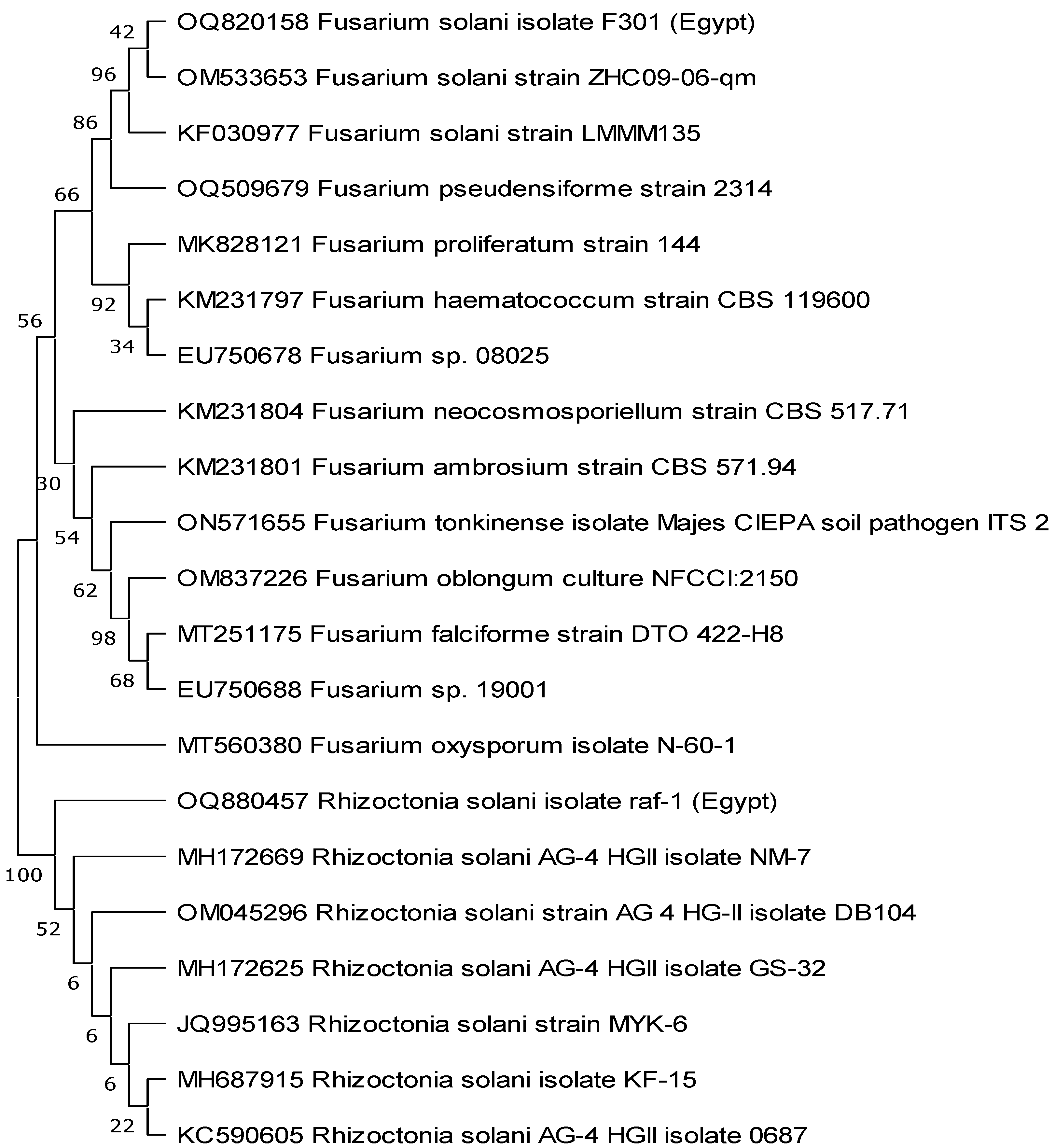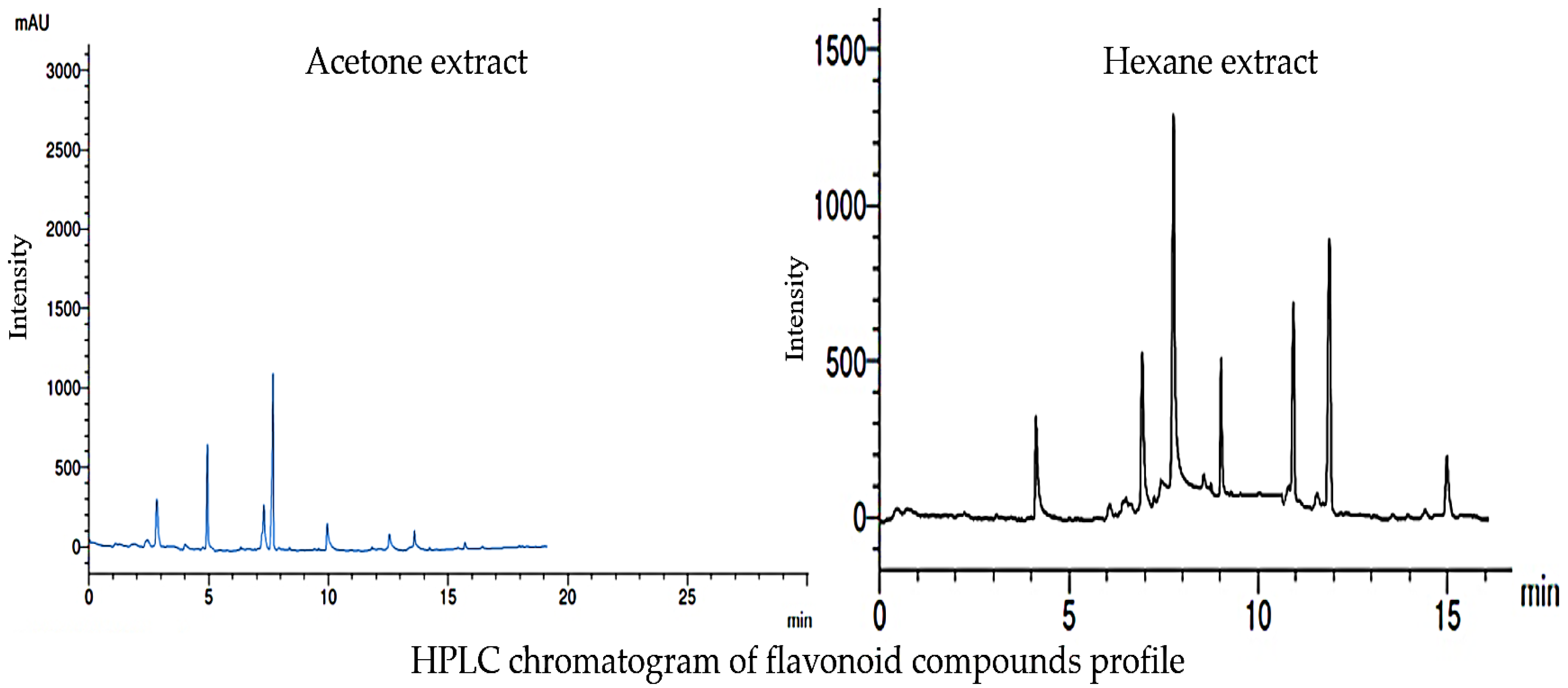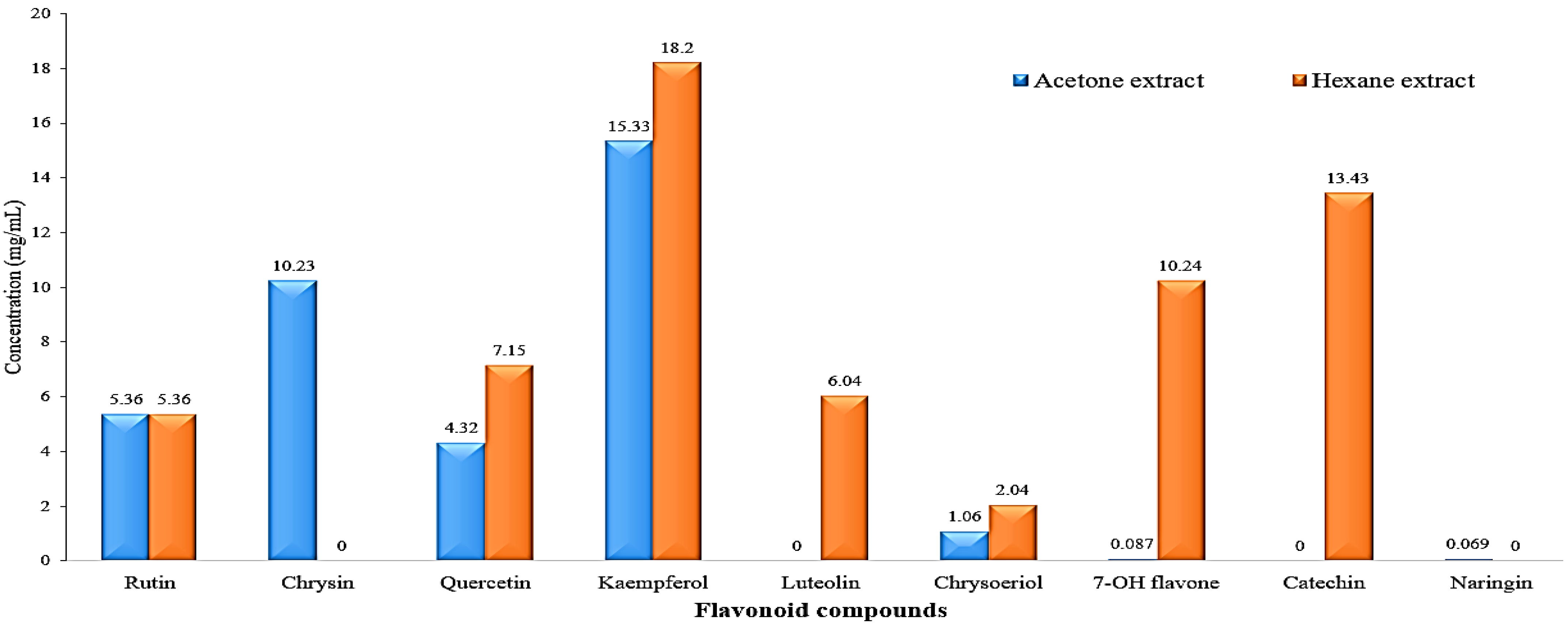Rhaphiolepis indica Fruit Extracts for Control Fusarium solani and Rhizoctonia solani, the Causal Agents of Bean Root Rot
Abstract
1. Introduction
2. Materials and Methods
2.1. Sample Collection, Isolation, and Purification of the Pathogen
2.2. In Vivo Test of the Isolated Fungal Isolates
- a.
- The fungi were cultured on potato dextrose agar (PDA) plates at 28 °C for 7–10 days. Once the fungi had grown, five plates of each fungus were scraped from the surface of the agar with a sterile loop and suspended in 250 mL of sterile distilled water.
- b.
- Sterile soil of equal parts peat moss, sand, and clay was put in 1 L pots in a greenhouse. After that, each pot received 50 mL of the fungal inoculum and was watered with 250 mL of water. The pots were kept for a week before two bean seeds (cv. Nebraska) were sown in each pot. Control plants were watered with sterile distilled water only.
- c.
- The plants were monitored regularly for symptoms of the disease. Symptoms on bean plants included wilting, yellowing, damping-off of the lower stem, and root rot.
- d.
- Finally, Koch’s postulates were used to re-isolate and identify the fungi by placing the infected cut sections on an agar medium.
2.3. Morphological and Molecular Characterization of Fungal Isolates
2.4. Preparation of Rhaphiolepis indica Fruit Samples for Analysis
2.5. In Vitro Evaluation of the Antifungal Effect of Rhaphiolepis indica Fruit Extracts
2.6. HPLC Analysis of R. indica Fruit Extracts
2.7. Statistical Analysis
3. Results
3.1. Isolation and Pathogenicity
3.2. Phenotypic Identification of the Fungal Isolates
- a.
- Mycelium: R. solani can grow as mycelium (fungal threads) that are initially white, but can turn brown or gray as they age. The mycelium can be either thick or thin and can form mats or strands, and it grows rapidly on nutrient-rich media.
- b.
- Sclerotia: The fungus produces dark, hard, irregularly shaped sclerotia. The size and shape of the sclerotia vary depending on the strain of R. solani.
- c.
- Hyphae: The hyphae of R. solani are septate, and they are often branched and irregular in shape.
- d.
- Spores: R. solani does not produce any distinctive conidial spores, and its mode of reproduction is primarily through vegetative means, such as mycelial growth and sclerotia formation.
- a.
- Colony appearance: F. solani colonies typically appear cottony or woolly in texture and are initially white, becoming yellow or tan as they mature.
- b.
- Growth rate: F. solani grows rapidly on potato dextrose agar (PDA) and other media, forming dense mycelial mats.
- c.
- Hyphae: The hyphae of Fusarium solani are septate, meaning they are divided into distinct segments by cross-walls called septa.
- d.
- Sporulation: F. solani produces a variety of spores, including macroconidia and microconidia, which are typically cylindrical or fusiform in shape.
- e.
- Microscopic characteristics: When viewed under a microscope, F. solani hyphae appear smooth, and the conidia are generally single-celled and have a distinct shape.
3.3. Identification of the Fungal Isolates by ITS-PCR
3.4. Phylogenetic Tree Construction
3.5. Effect of Rhaphiolepis Fruit Extracts on the Growth of F. solani and R. solani In Vitro
3.6. Polyphenolic Compounds in R. indica Fruit Extracts
3.6.1. Phenolic Compound Profiles
3.6.2. Flavonoid Compound Profiles
4. Discussion
5. Conclusions
Author Contributions
Funding
Data Availability Statement
Acknowledgments
Conflicts of Interest
References
- Soliman, S.A.; Al-Askar, A.A.; Sobhy, S.; Samy, M.A.; Hamdy, E.; Sharaf, O.A.; Su, Y.; Behiry, S.I.; Abdelkhalek, A. Differences in Pathogenesis-Related Protein Expression and Polyphenolic Compound Accumulation Reveal Insights into Tomato—Pythium aphanidermatum Interaction. Sustainability 2023, 15, 6551. [Google Scholar]
- Sobhy, S.; Al-Askar, A.A.; Bakhiet, E.K.; Elsharkawy, M.M.; Arishi, A.A.; Behiry, S.I.; Abdelkhalek, A. Phytochemical Characterization and Antifungal Efficacy of Camphor (Cinnamomum camphora L.) Extract against Phytopathogenic Fungi. Separations 2023, 10, 189. [Google Scholar]
- Mdee, L.K.; Masoko, P.; Eloff, J.N. The activity of extracts of seven common invasive plant species on fungal phytopathogens. S. Afr. J. Bot. 2009, 75, 375–379. [Google Scholar]
- Hostettmann, K.; Marston, A.; Ndjoko, K.; Wolfender, J.-L. The potential of African plants as a source of drugs. Curr. Org. Chem. 2000, 4, 973–1010. [Google Scholar]
- Behiry, S.; Soliman, S.A.; Massoud, M.A.; Abdelbary, M.; Kordy, A.M.; Abdelkhalek, A.; Heflish, A. Trichoderma pubescens Elicit Induced Systemic Resistance in Tomato Challenged by Rhizoctonia solani. J. Fungi 2023, 9, 167. [Google Scholar] [CrossRef]
- Koch, E.; Roberts, S.J. Non-chemical seed treatment in the control of seed-borne pathogens. In Global Perspectives on the Health of Seeds and Plant Propagation Material; Springer: Berlin/Heidelberg, Germany, 2014; pp. 105–123. [Google Scholar]
- Choudhury, D.; Dobhal, P.; Srivastava, S.; Saha, S.; Kundu, S. Role of botanical plant extracts to control plant pathogens-A review. Indian J. Agric. Res. 2018, 52, 341–346. [Google Scholar]
- Behiry, S.I.; Soliman, S.A.; Al-Askar, A.A.; Alotibi, F.O.; Basile, A.; Abdelkhalek, A.; Elsharkawy, M.M.; Salem, M.Z.M.; Hafez, E.E.; Heflish, A.A. Plantago lagopus extract as a green fungicide induces systemic resistance against Rhizoctonia root rot disease in tomato plants. Front. Plant Sci. 2022, 13, 2818. [Google Scholar] [CrossRef]
- Parveen, S.; Wani, A.H.; Bhat, M.Y.; Malik, A.R.; Koka, J.A.; Ashraf, N. Antimycotic potential of some phytoextracts on some pathogenic fungi. J. Biopestic. 2017, 10, 60–65. [Google Scholar] [CrossRef]
- Nazzaro, F.; Fratianni, F.; Coppola, R.; Feo, V. De Essential oils and antifungal activity. Pharmaceuticals 2017, 10, 86. [Google Scholar]
- Behiry, S.I.; Philip, B.; Salem, M.Z.M.; Amer, M.A.; El-Samra, I.A.; Abdelkhalek, A.; Heflish, A. Urtica dioica and Dodonaea viscosa leaf extracts as eco-friendly bioagents against Alternaria alternata isolate TAA-05 from tomato plant. Sci. Rep. 2022, 12, 16468. [Google Scholar]
- Shuping, D.S.S.; Eloff, J.N. The use of plants to protect plants and food against fungal pathogens: A review. Afr. J. Tradit. Complement. Altern. Med. 2017, 14, 120–127. [Google Scholar]
- Youssef, N.H.; Qari, S.H.; Behiry, S.I.; Dessoky, E.S.; El-Hallous, E.I.; Elshaer, M.M.; Kordy, A.; Maresca, V.; Abdelkhalek, A.; Heflish, A.A. Antimycotoxigenic Activity of Beetroot Extracts against Altenaria alternata Mycotoxins on Potato Crop. Appl. Sci. 2021, 11, 4239. [Google Scholar] [CrossRef]
- Dong, Z.; Qu, S.; Landrein, S.; Yu, W.-B.; Xin, J.; Zhao, W.; Song, Y.; Tan, Y.; Xin, P. Increasing taxa sampling provides new insights on the phylogenetic relationship between Eriobotrya and Rhaphiolepis. Front. Genet. 2022, 13, 831206. [Google Scholar]
- Rajalakshmi, P.; Code, Q.R. Nutraceutical studies on Eriobotrya japonica (Thunb.) Lindl. (Fruits & Seeds). Int. J. Adv. Sci. Res. 2017, 3, 44–48. [Google Scholar]
- Ngugi, M.P.; Maingi, J. Phytochemical Screening of Aqueous Leaf, Stem Bark and Root Extracts of Rhaphiolepis bibas (Lour.). Int. J. Innov. Sci. Res. Technol. 2013, 8, 1140–1144. [Google Scholar]
- Broughton, W.J.; Hernández, G.; Blair, M.; Beebe, S.; Gepts, P.; Vanderleyden, J. Beans (Phaseolus spp.)—Model food legumes. Plant Soil 2003, 252, 55–128. [Google Scholar] [CrossRef]
- Thompson, M.D.; Brick, M.A.; McGinley, J.N.; Thompson, H.J. Chemical composition and mammary cancer inhibitory activity of dry bean. Crop Sci. 2009, 49, 179–186. [Google Scholar]
- Siddiq, M.; Ravi, R.; Harte, J.B.; Dolan, K.D. Physical and functional characteristics of selected dry bean (Phaseolus vulgaris L.) flours. LWT-Food Sci. Technol. 2010, 43, 232–237. [Google Scholar]
- Kutoš, T.; Golob, T.; Kač, M.; Plestenjak, A. Dietary fibre content of dry and processed beans. Food Chem. 2003, 80, 231–235. [Google Scholar]
- Zitnick-Anderson, K.; Oladzadabbasabadi, A.; Jain, S.; Modderman, C.; Osorno, J.M.; McClean, P.E.; Pasche, J.S. Sources of resistance to Fusarium solani and associated genomic regions in common bean diversity panels. Front. Genet. 2020, 11, 475. [Google Scholar]
- Elewa, I.S.; Ahmed, M.A.; Moustafa, A.M. Grouping of Rhizoctonia solani Kuhn in Egypt and their pathogenic effect on different host plants [corn, broad bean, cabbage, squash, clover, cucumber]. Ann. Agric. Sci. 1994, 123–146. [Google Scholar]
- Sneh, B.; Burpee, L.; Qgoshi, A. Identification of Rhizoctonia Species; APS Press: St. Paul, MN, USA, 1991. [Google Scholar]
- Van der Plaats-Niterink, A.J. Monogrpah of the Genus Pythium. In Studies Mycology No. 21; Centra Albareau vor Schimmel Cultures: Baarh, The Netherlands, 1981. [Google Scholar]
- Leck, A. Lactophenol Cotton Blue Slide Mounts. Community Eye Health 1999, 12, 24. [Google Scholar] [PubMed]
- Tiwari, K.L.; Jadhav, S.K.; Gupta, S. Modified CTAB technique for isolation of DNA from some medicinal plants. Res. J. Med. Plant 2012, 6, 65–73. [Google Scholar] [CrossRef]
- Sambrook, J.; Fritsch, E.F.; Maniatis, T. Molecular Cloning: A Laboratory Manual; University of Texas South Western Medical Center: Cold Spring Harbor, NY, USA, 1989. [Google Scholar]
- Tamura, K.; Stecher, G.; Kumar, S. MEGA11: Molecular Evolutionary Genetics Analysis Version 11. Mol. Biol. Evol. 2021, 38, 3022–3027. [Google Scholar] [CrossRef] [PubMed]
- Heflish, A.A.; Abdelkhalek, A.; Al-Askar, A.A.; Behiry, S.I. Protective and Curative Effects of Trichoderma asperelloides Ta41 on Tomato Root Rot Caused by Rhizoctonia solani Rs33. Agronomy 2021, 11, 1162. [Google Scholar]
- El-Bilawy, E.H.; Al-Mansori, A.-N.A.; Soliman, S.A.; Alotibi, F.O.; Al-Askar, A.A.; Arishi, A.A.; Sabry, A.E.-N.; Elsharkawy, M.M.; Heflish, A.A.; Behiry, S.I. Antifungal, Antiviral, and HPLC Analysis of Phenolic and Flavonoid Compounds of Amphiroa anceps Extract. Sustainability 2022, 14, 12253. [Google Scholar]
- Fiorito, S.; Ianni, F.; Preziuso, F.; Epifano, F.; Scotti, L.; Bucciarelli, T.; Genovese, S. UHPLC-UV/Vis quantitative analysis of hydroxylated and O-prenylated coumarins in pomegranate seed extracts. Molecules 2019, 24, 1963. [Google Scholar]
- Abdelkhalek, A.; Hafez, E. Plant Viral Diseases in Egypt and Their Control. In Cottage Industry of Biocontrol Agents and Their Applications; Springer: Berlin/Heidelberg, Germany, 2020; pp. 403–421. [Google Scholar]
- Gerlach, W.; Nirenberg, H. The Genus Fusarium: A Pictorial Atlas (Mitteilungen aus der Biologischen Bundesanstalt fur Land-und Forstwirtschaft Berlin-Dahlem); Kommissionsverlag P. Parey: Berlin, Germany, 1982. [Google Scholar]
- Seepe, H.A.; Amoo, S.O.; Nxumalo, W.; Adeleke, R.A. Antifungal activity of medicinal plant extracts for potential management of Fusarium pathogens. Res. Crops 2019, 20, 399–406. [Google Scholar]
- Parekh, J.; Chanda, S. In vitro antimicrobial activity and phytochemical analysis of some Indian medicinal plants. Turk. J. Biol. 2007, 31, 53–58. [Google Scholar]
- Van Vuuren, S.F.; Naidoo, D. An antimicrobial investigation of plants used traditionally in southern Africa to treat sexually transmitted infections. J. Ethnopharmacol. 2010, 130, 552–558. [Google Scholar]
- Kitonde, C.K.; Fidahusein, D.S.; Lukhoba, C.W.; Jumba, M.M. Antimicrobial activity and phytochemical screening of Senna didymobotrya used to treat bacterial and fungal infections in Kenya. Int. J. Educ. Res. 2014, 2, 1–12. [Google Scholar]
- Bhattacharjee, I.; Chatterjee, S.K.; Ghosh, A.; Chandra, G. Antibacterial activities of some plant extracts used in Indian traditional folk medicine. Asian Pac. J. Trop. Biomed. 2011, 1, S165–S169. [Google Scholar]
- Ashmawy, N.A.; Salem, M.Z.M.; El Shanhorey, N.; Al-Huqail, A.; Ali, H.M.; Behiry, S.I. Eco-friendly wood-biofungicidal and antibacterial activities of various Coccoloba uvifera L. leaf extracts: HPLC analysis of phenolic and flavonoid compounds. BioResources 2020, 15, 4165–4187. [Google Scholar]
- Deena, M.J.; Thoppil, J.E. Antimicrobial activity of the essential oil of Lantana camara. Fitoterapia 2000, 71, 453–455. [Google Scholar]
- Valarini, P.J.; de Melo, I.S.; Morsoletto, R.V. Alternative control of root rot of common beans (Phaseolus vulgaris L.). Summa Phytopathol. 2003, 29, 334–339. [Google Scholar]
- Christaki, E.; Bonos, E.; Giannenas, I.; Florou-Paneri, P. Aromatic plants as a source of bioactive compounds. Agriculture 2012, 2, 228–243. [Google Scholar]
- Martins, N.; Barros, L.; Henriques, M.; Silva, S.; Ferreira, I.C.F.R. Activity of phenolic compounds from plant origin against Candida species. Ind. Crops Prod. 2015, 74, 648–670. [Google Scholar]
- Acheuk, F.; Basiouni, S.; Shehata, A.A.; Dick, K.; Hajri, H.; Lasram, S.; Yilmaz, M.; Emekci, M.; Tsiamis, G.; Spona-Friedl, M. Status and prospects of botanical biopesticides in Europe and Mediterranean countries. Biomolecules 2022, 12, 311. [Google Scholar]
- Bhardwaj, S.K. Evaluation of plant extracts as antifungal agents against Fusarium solani (Mart.) Sacc. World J. Agric. Sci. 2012, 8, 385–388. [Google Scholar]
- Choudhury, D.; Anand, Y.R.; Kundu, S.; Nath, R.; Kole, R.K.; Saha, J. Effect of plant extracts against sheath blight of rice caused by Rhizoctonia solani. J. Pharmacogn. Phytochem. 2017, 6, 399–404. [Google Scholar]
- Yavuz, A.; Onaran, A.; Bayar, Y. Endemik Serik Armudu (Pyrus serikensis)’nun Yaprak ve Meyve Ekstraktlarının Bazı Bitki Patojeni Funguslara Karşı Biyofungusidal Aktivitesi. Türk Tarım ve Doğa Bilimleri Dergisi 2022, 9, 256–262. [Google Scholar]
- Onaran, A.; Başaran, M. Determination of antifungal activity and phenolic compounds of endemic Muscari aucheri (Boiss.) baker extract. Gaziosmanpaşa Üniversitesi Ziraat Fakültesi Dergisi 2018, 35, 60–67. [Google Scholar]
- Sikkema, J.A.N.; de Bont, J.A.; Poolman, B. Mechanisms of membrane toxicity of hydrocarbons. Microbiol. Rev. 1995, 59, 201–222. [Google Scholar] [PubMed]
- Bajpai, V.K.; Sharma, A.; Baek, K.-H. Antibacterial mode of action of Ginkgo biloba leaf essential oil: Effect on morphology and membrane permeability. Bangladesh J. Pharmacol. 2015, 10, 337–350. [Google Scholar]
- Wu, H.-S.; Raza, W.; Fan, J.-Q.; Sun, Y.-G.; Bao, W.; Shen, Q.-R. Cinnamic acid inhibits growth but stimulates production of pathogenesis factors by in vitro cultures of Fusarium oxysporum f. sp. niveum. J. Agric. Food Chem. 2008, 56, 1316–1321. [Google Scholar]
- Korošec, B.; Sova, M.; Turk, S.; Kraševec, N.; Novak, M.; Lah, L.; Stojan, J.; Podobnik, B.; Berne, S.; Zupanec, N. Antifungal activity of cinnamic acid derivatives involves inhibition of benzoate 4-hydroxylase (CYP 53). J. Appl. Microbiol. 2014, 116, 955–966. [Google Scholar]
- El Sawi, S.; Moawad, D.; El Alfy, S. Activity of Chorisia insignis HBK. against larynx carcinoma and chemical investigation of its polar extracts. J. Appl. Sci. Res. 2012, 8, 5564–5571. [Google Scholar]
- Mohamed, A.A.; Behiry, S.I.; Ali, H.M.; EL-Hefny, M.; Salem, M.Z.M.; Ashmawy, N.A. Phytochemical compounds of branches from P. halepensis oily liquid extract and S. terebinthifolius essential oil and their potential antifungal activity. Processes 2020, 8, 330. [Google Scholar]






| Rhaphiolepis indica Fruit Extracts | Concentration | Inhibition Percentage (%) of Fungal Isolates ± Standard Deviation | |
|---|---|---|---|
| Fusarium solani | Rhizoctonia solani | ||
| Control | 00.00 ± 0.00 g * | 00.00 ± 0.00 f | |
| Acetone extract | 1% | 46.19 ± 2.94 e | 00.00 ± 0.00 f |
| 2% | 55.24 ± 1.78 d | 70.95 ± 2.94 c | |
| 3% | 60.00 ± 1.17 b | 79.52 ± 0.67 a | |
| Hexane extract | 1% | 44.76 ± 1.78 f | 13.81 ± 0.67 e |
| 2% | 57.62 ± 1.78 c | 70.48 ± 2.43 d | |
| 3% | 84.76 ± 1.15 a | 85.24 ± 0.58 a | |
Disclaimer/Publisher’s Note: The statements, opinions and data contained in all publications are solely those of the individual author(s) and contributor(s) and not of MDPI and/or the editor(s). MDPI and/or the editor(s) disclaim responsibility for any injury to people or property resulting from any ideas, methods, instructions or products referred to in the content. |
© 2023 by the authors. Licensee MDPI, Basel, Switzerland. This article is an open access article distributed under the terms and conditions of the Creative Commons Attribution (CC BY) license (https://creativecommons.org/licenses/by/4.0/).
Share and Cite
Heflish, A.A.; Behiry, S.I.; Al-Askar, A.A.; Su, Y.; Abdelkhalek, A.; Gaber, M.K. Rhaphiolepis indica Fruit Extracts for Control Fusarium solani and Rhizoctonia solani, the Causal Agents of Bean Root Rot. Separations 2023, 10, 369. https://doi.org/10.3390/separations10070369
Heflish AA, Behiry SI, Al-Askar AA, Su Y, Abdelkhalek A, Gaber MK. Rhaphiolepis indica Fruit Extracts for Control Fusarium solani and Rhizoctonia solani, the Causal Agents of Bean Root Rot. Separations. 2023; 10(7):369. https://doi.org/10.3390/separations10070369
Chicago/Turabian StyleHeflish, Ahmed A., Said I. Behiry, Abdulaziz A. Al-Askar, Yiming Su, Ahmed Abdelkhalek, and Mohamed K. Gaber. 2023. "Rhaphiolepis indica Fruit Extracts for Control Fusarium solani and Rhizoctonia solani, the Causal Agents of Bean Root Rot" Separations 10, no. 7: 369. https://doi.org/10.3390/separations10070369
APA StyleHeflish, A. A., Behiry, S. I., Al-Askar, A. A., Su, Y., Abdelkhalek, A., & Gaber, M. K. (2023). Rhaphiolepis indica Fruit Extracts for Control Fusarium solani and Rhizoctonia solani, the Causal Agents of Bean Root Rot. Separations, 10(7), 369. https://doi.org/10.3390/separations10070369










